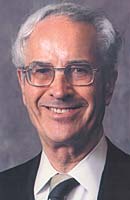Postlude
A Life of Service Through the Law
 For Charles S. Rhyne, JD ’37, law was a way of life and the way to change the world. He used his knowledge of and love for the law to promote freedom and peace—and to fight racism and oppression. When he passed away on July 27, 2003, he left in our memories a legacy of activism and service.
For Charles S. Rhyne, JD ’37, law was a way of life and the way to change the world. He used his knowledge of and love for the law to promote freedom and peace—and to fight racism and oppression. When he passed away on July 27, 2003, he left in our memories a legacy of activism and service.
At GW, he was elected to the Law Review and developed a lifelong interest in municipal law. Through his work with Professor John McIntire, Rhyne began work for the U.S. Conference of Mayors, which was then led by Mayors Fiorello LaGuardia of New York and Harold Burton of Cleveland, and its newly created association of city attorneys. They selected Rhyne to argue his first case in the Supreme Court when he was only two years out of law school, and he appeared before the court several times during the next 45 years. He also practiced law independently with Rhyne & Rhyne, which he founded with his brother, Brice Rhyne, throughout his career.
In 1955, he was elected president of the Bar Association of the District of Columbia and upheld his election promise of desegregating the association, an accomplishment for which he received a BADC “Heroes in Law” award four decades later.
In the early ’60s, he fought racism again in a landmark U.S. Supreme Court case, Baker v. Carr. The case was described by former Chief Justice Earl Warren as “the most important case of my tenure on the court.” The court held as unconstitutional the under-representation in state legislatures of urban voters—which resulted from refusal to re-apportion electoral districts to reflect the cities’ population growth. Baker ended the long period of the court’s refusal to intervene to correct unconstitutional state action on the ground the state decisions were “political.” Rhyne’s GW moot court partner, William Doyle, also played a major role in the civil rights movement by helping to desegregate schools in Colorado.
Rhyne’s interest in promoting freedom and tolerance extended around the globe. As the youngest president of the American Bar Association, Rhyne created “Law Day USA,” which celebrated the rule of law that governed free nations. The celebration was inspired by the ceremonies held on the streets of Moscow each May after the USSR erected the Iron Curtain. He was pictured on the cover of Time for the accomplishment.
Working with lawyers around the world, he erected a memorial to the Magna Carta, the unveiling of which was attended by Winston Churchill. The memorial is displayed near Windsor Castle today. Rhyne’s other initiatives include the World Peace Through Law Center, which is now the World Jurist Association of World Peace Through Law.
For these and many other achievements, Rhyne was nominated for Nobel Peace Prizes in 1966 and 1994. His accomplishments remind the GW Law community that the practice is more than a career, it is a catalyst for change and a service to humankind.
—Laura Ewald, with thanks to William S. Rhyne, JD ’74